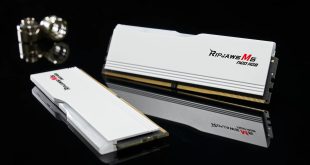Samsung Electronics on Tuesday said that it had begun mass production of dynamic random access memory using 20nm process technology. The new fabrication tech will not only enable the company to produce more energy-efficient DDR3 memory, but will also reduce manufacturing cost of DRAM and will thus make it more competitive than its rivals.
According to Samsung, 4Gb DDR3 DRAM chips made using 20nm feature improved manufacturing productivity, which is over 30 per cent higher than that of the preceding 25 nanometer DDR3, and more than twice that of 30nm-class DDR3. In addition, the new 20nm 4Gb DDR3-based modules can save up to 25 per cent of the energy consumed by equivalent modules fabricated using the previous 25nm process technology.
Samsung’s rivals, such as SK Hynix and Micron Technology manufacture DDR3 DRAM using 30nm process technologies these days and thus their products are more expensive to make. Earlier this year a report already said that Samsung tried to sell its 25nm DDR3 ICs at lower prices (compared to other makers’) to boost its market share.
With DRAM memory, where each cell consists of a capacitor and a transistor linked to one another, scaling is more difficult than with NAND flash memory in which a cell only needs a transistor. To continue scaling for more advanced DRAM, Samsung improved its design and manufacturing technologies and came up with a modified double patterning and atomic layer deposition.
Samsung’s modified double patterning technology marks a new milestone, by enabling 20nm DDR3 production using current ArF photolithography equipment and establishing the core technology for the next generation of 10nm-class DRAM production. Samsung also successfully produced ultrathin dielectric layers of cell capacitors with a unique uniformity, which has resulted in higher cell performance.
“Samsung’s new energy-efficient 20nm DDR3 DRAM will rapidly expand its market base throughout the IT industry including the PC and mobile markets, quickly moving to mainstream status,” said Young-Hyun Jun, executive vice president, memory sales and marketing at Samsung Electronics. “Samsung will continue to deliver next-generation DRAM and green memory solutions ahead of the competition, while contributing to the growth of the global IT market in close cooperation with our major customers.”
According to market research data from Gartner, the global DRAM market will grow from $35.6 billion in 2013 to $37.9 billion in 2014.
KitGuru Says: While it is unknown whether Samsung is really trying to grab a significant market shares from its competitors by selling DRAM at a price below the market’s average, the important thing is that it can do it pretty easily. However, given low demand towards memory for PCs these days, the buyers will have stronger influence on DRAM price than the sellers in general…
 KitGuru KitGuru.net – Tech News | Hardware News | Hardware Reviews | IOS | Mobile | Gaming | Graphics Cards
KitGuru KitGuru.net – Tech News | Hardware News | Hardware Reviews | IOS | Mobile | Gaming | Graphics Cards



